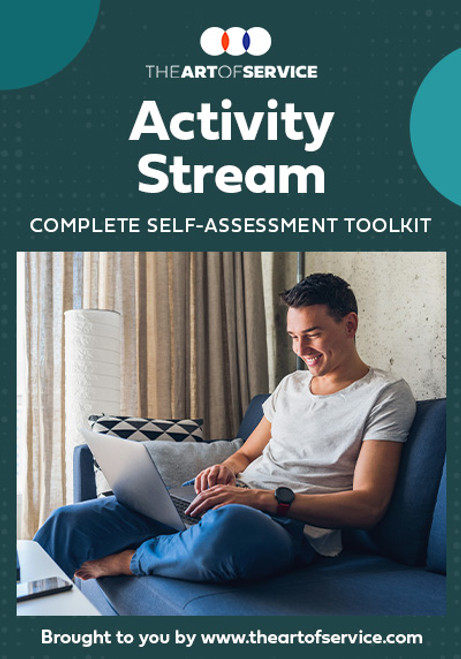This Instant-Access Self-Assessment Excel Dashboard and accompanying eBook is for managers, advisors, consultants, specialists, professionals and anyone interested in Value stream mapping assessment.
'Visual analytics brought lot of value to the organization. Creating a dashboard was relatively easy.' - CIO in the Government Industry
'Working with The Art of Service was very straightforward. We were able to complete the initiative without any hand holding. The implementation was self-driven, knowing that The Art of Service was there if there was need for help. Given our knowledge with BI tools, this transfered well with use of The Art of Service's self assessment. Also, their offering made the initiative costs-effective lowering overall cost of ownership for the solution.' - Managing Principal in the Services Industry
'TAOS's self-assessment was one of the most successful initiatives we have undertaken in recent years' - Director of Information Technology in the Manufacturing Industry
What Is The Value stream mapping Self-Assessment?
The Value stream mapping Self-Assessment's Purpose is:
- To help our clients to reduce their effort in the Value stream mapping work they do to get their problem solved
- To help our clients in ensuring that their plans of action include every Value stream mapping task and that every Value stream mapping outcome is in place
- To help our clients not having to spend time investigating strategic and tactical options, therefore saving time and ensuring Value stream mapping opportunity costs are low
- To help our clients channel implementation direction instantly to deliver tailored Value stream mapping advise with structured going-forward plans
All the tools you need to an in-depth Value stream mapping Self-Assessment. Featuring 620 new and updated case-based questions, organized into seven core areas of process design, this Self-Assessment will help you identify areas in which Value stream mapping improvements can be made.
What You Get:
The Value stream mapping Complete Self-Assessment Excel Dashboard
- Ensures you don't miss anything: 620 questions in 7 RDMAICS (Recognize, Define, Measure, Analyze, Improve, Control and Sustain) steps with easy and quick navigating and answering for 1 or up to 10 participants
- Shows your organization instant insight in areas for improvement: Auto generates reports, radar chart for maturity assessment, insights per process and participant and bespoke, ready to use, RACI Matrix
- Gives you a professional Dashboard to guide and perform a thorough Value stream mapping Self-Assessment
- Dynamically generated projects-ready RACI Matrix shows your organization exactly what to do next
- Is secure: Ensures offline data protection of your Self-Assessment results
The Value stream mapping Complete Self Assessment eBook version of the book in print
- Provides a convenient way to distribute and share among the participants to prepare and discuss the Self-Assessment
In using the Self-Assessment you will be better able to:
- Diagnose Value stream mapping projects, initiatives, organizations, businesses and processes using accepted diagnostic standards and practices
- Implement evidence-based best practice strategies aligned with overall goals
- Integrate recent advances in Value stream mapping and process design strategies into practice according to best practice guidelines
Assess and define Value stream mapping with this Value stream mapping Self Assessment. Sample questions from the Complete, 620 Questions, Self-Assessment:
- Recognize Question: Which individuals, teams or departments will be involved in Value stream mapping?
- Define Question: What will drive Value stream mapping change?
- Measure Question: In what ways are Value stream mapping vendors and us interacting to ensure safe and effective use?
- Analyze Question: How do we keep improving Value stream mapping?
- Improve Question: Who will be responsible for deciding whether Value stream mapping goes ahead or not after the initial investigations?
- Control Question: Think about the kind of project structure that would be appropriate for your Value stream mapping project. should it be formal and complex, are can it be less formal and relatively simple?
- Sustain Question: How can you measure Value stream mapping in a systematic way?
Value [to you] of the Value stream mapping Self-Assessment
Excluding hired consultants and advisors from top management consulting firms, internal Value stream mapping Self-Assessment work is typically undertaken by senior level positions with titles such as Enterprise Architect, Business Process Architects, Business Process Re-engineering Specialists and Business Architects.
Statistics according to Glassdoor and Indeed tell these positions receive an average basic pay of $125,000. Daily rates of basic pay are computed by dividing an employee's annual pay by 260 days. The daily salary is then derived by dividing the annual salary of $125,000 by 260 days = a daily rate of $480.
Top management consulting firms start at $2,000 a day, with rates typically charged up to 40 hours per week.
For the price of a fraction of this you can get complete peace of mind. Now.
Defining, designing, creating, and implementing a process to solve a business challenge or meet a business objective is the most valuable role… In EVERY company, organization and department.
Unless you are talking a one-time, single-use project within a business, there should be a process. Whether that process is managed and implemented by humans, AI, or a combination of the two, it needs to be designed by someone with a complex enough perspective to ask the right questions. Someone capable of asking the right questions and step back and say, 'What are we really trying to accomplish here? And is there a different way to look at it?'
For more than twenty years, The Art of Service's Self-Assessments empower people who can do just that - whether their title is marketer, entrepreneur, manager, salesperson, consultant, business process manager, executive assistant, IT Manager, CxO etc... - they are the people who rule the future. They are people who watch the process as it happens, and ask the right questions to make the process work better.
You are free to use the Self-Assessment contents in your presentations and documentation for internal end external use without asking us - we are here to help.







